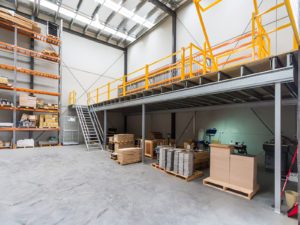10 Tips To Optimise Your Warehouse
October 23, 2023 Warehousing
If you run or work in a warehouse, it’s important that it’s run as optimally as possible. Whether that means maximising storage, reducing picking and packing time, or keeping costs, down, warehouse design and optimisation is important for any business that relies on logistics.
Warehouse owners often default to “let’s find a bigger space” to solve many of these problems, but a warehouse relocation can be costly and also be disruptive to your business. Because of this, figuring out how to use your existing space as effectively as possible should be your first consideration before simply relocating.
With that being said, another common idea when it comes to optimising warehouses is to automate where possible and/or use robots. While automisation and robotics are a great way to get the most out of a warehouse, these options aren’t always possible due to price, industry, or application. If you can get an automated solution to your warehousing, it’s definitely worth considering, but if you can’t (or you’re looking for other ideas as well), read on for 10 tips to optimise your warehouse.
1. Consider what you’re trying to improve
When we first start working with clients, many of them say they want their warehouse to operate better, but what does that mean? Do they want more efficient storage? Do they want more efficient picking and packing time? Or do they want to reduce costs? Most warehouse operators probably want to achieve all three when optimising their warehouse, but they’re also three separate problems. Sure, these things are connected, but you also have to figure out what the problem is in order to find a solution. Or maybe you want to improve another aspect of your warehouse. Keep that in mind before you start with random fixes.
2. Keep safety as the number one priority
This tip probably should have been number one, but when mapping out any plan, you need to find the problem first. But yes, safety always needs to be the highest priority in any industrial setting, including warehousing. You don’t want to get hurt at work and you don’t want your warehousing team to get hurt at work either, this is just the right attitude to have. But how can safety also help improve the efficiency of a warehouse?
A warehouse free of tripping hazards, with good lighting, safety barriers, and clear walkways to keep pedestrians out of the way of machinery means workers can perform their duties more quickly and with more confidence. What’s more even a relatively minor trip or slip slows down the whole warehouse operation, so even small breaches in safety need to be avoided to keep a warehouse operating at its peak.
3. Install a raised storage area

If you’re concerned about warehouse storage, consider installing a mezzanine raised storage area. Although full height pallet racking can be a good option to use all the vertical space in a warehouse, this isn’t appropriate for all businesses. Because of this, a raised storage area may be the best way to use all the vertical space in your warehouse.
A mezzanine raised storage area can cover only part of your warehouse all the way up to covering your entire warehouse, effectively doubling your floor space.
4. Install conveyor belts
A lot of time is wasted in warehouses through workers having to travel from one area of the warehouse to another, conveyor belts can solve this problem.
If you already have a raised storage area or area considering installing one, you may be concerned about the time it will take workers to travel up and down stairs. Having an upstairs team passing goods down to a downstairs team via gravity conveyor belts solves this problem.
In fact, relatively simple conveyor systems can be designed to quickly and easily send goods from one end of a warehouse to another, preventing employees having to manually move goods large distances.
5. Ensure you have the right pallet racking and shelving for your warehouse
Difference types of warehouse pallet racking and shelving have their own pros and cons and different applications based on what’s being stored. There’s no “one size fits all” when it comes to pallet racking and shelving.
Drive in pallet racking, for example, can be great for high density storage but not useful if you have stock that needs to be managed on a first in first out basis. Meanwhile, a pallet live storage system allows for easy to manage first in first out stock, but doesn’t have the density of drive in pallet racking.
Ultimately, there’s a solution out there for every circumstance, but a solution that worked for one warehouse may not work for another. Of course replacing all of your pallet racking or shelving may be expensive, but businesses like us at A1 Precision Solutions have pallet racking buy back options that will reduce the overall cost of buying new racking. Then your warehouse is more efficient, reducing overall costs.
6. Ensure high velocity items are near packing areas
This may seem obvious to some, but put the items that are shipped the most frequently close to your packing area. You may even want to consider reorganising your warehouse on a seasonal basis if that will reduce travel time for warehouse workers and overall raise efficiency.
This is all about reducing picking and packing time and costs by needing fewer workers since they’re working more quickly.
7. Upgrade and maintain your materials handling equipment
Technology changes in materials handling equipment happen all the time, when was the last time you considered upgrading yours? Or maybe your forklift isn’t running as well as it should be, posing both a safety risk while also slowing down materials transport within the warehouse, it may need to be replaced. While no warehouse manager wants to have to spend money on new materials handling equipment, it could end up paying for itself through a more efficient warehouse.
8. Outsource tasks or get temporary workers
If your warehouse efficiency problem is temporary or seasonal, spending money on a permanent solution may not be the way to go. Instead, getting some temporary workers into the warehouse to help or outsourcing tasks to another company may be a better idea. At the very least, finding a temporary solution may give you the time to determine the real problem in the warehouse and find a better solution.
9. Use software
Even small warehouses can benefit from warehouse management software. Warehouse management software (WMS) can show warehouse managers reports of warehouse operations including the flow of goods, stock locations, and other efficiency metrics to not only help in decision making, but also give managers recommendations as well.
10. Hire an expert
Sometimes you need an expert in warehouse optimisation and design to give you the best advice. Running a warehouse efficiently is hard work, so getting ideas from outside parties may be the best way to get more out of your warehouse itself, as well as your warehousing team.
If you need a more optimised warehouse. Contact us today.
